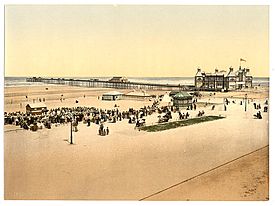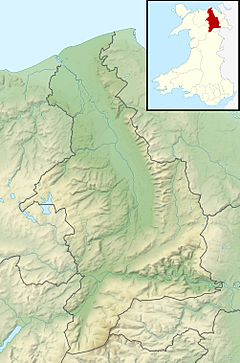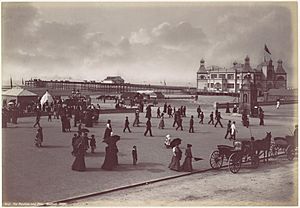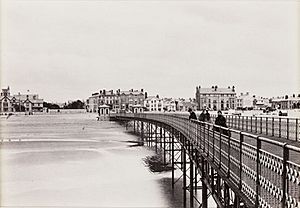Rhyl Pier facts for kids
 |
|
| Type | Pleasure |
|---|---|
| Carries | Pedestrians |
| Locale | Rhyl |
| Design | James Brunlees |
| Total length | 2,355 feet (718 m) |
| Opening date | 19 August 1867 |
| Destruction date | 1966 |
| Coordinates | 53°19′25″N 3°29′32″W / 53.32355°N 3.49211°W |
The Rhyl Pier, also known as the Victoria Pier, was a fun place to visit in the seaside town of Rhyl, Wales. It was the very first pier built in North Wales!
Opened in August 1867, this pier was super long, stretching about 2,355 feet (718 meters) into the sea. For many years, it was the main attraction in Rhyl. People argued about where to build it, but they finally decided on a spot near the middle of the town's esplanade (a fancy word for a seaside walkway).
Sadly, the pier faced many problems over its lifetime. Several boats crashed into it, especially in the late 1800s. In 1897, a famous diver named Tommy Burns tried a dangerous 100-foot dive off the pier. About 3,000 people watched, but he sadly died shortly after being pulled from the water.
In 1891, a huge building called the Grand Pavilion was added to the pier. It had the world's biggest organ, called the Grand Jubilee Organ, which weighed 25 tons! After years of neglect, the Rhyl Council bought the pier in the 1920s. It was used again from the 1930s until the mid-1960s. By then, it was too unsafe and was closed. The pier was finally taken down in 1973.
Contents
Where Was the Rhyl Pier Located?
The Rhyl Pier was built on the East Parade, right across from Church Street. At the end closest to the shore, there was a large Grand Pavilion and some toll houses where you paid to enter. A smaller building called the Bijou Pavilion was also nearby.
Originally, some people wanted the pier built at Kinmel Bay (which was called Foryd back then). They thought this spot could also be used to transport farm animals, not just tourists. But after many discussions and asking the community, it was decided to build the pier closer to the town center. The pier company's chairman, John Churton, said a town center pier would cost about £25,000, while one at Foryd would be cheaper at £15,000.
How the Rhyl Pier Was Built
Planning the Pier's Construction
People first thought about building a pier in Rhyl in the mid-1800s. This was because the Chester and Holyhead Railway arrived in 1848, making Rhyl a popular place for seaside holidays. Steamboats brought visitors, but they had trouble using the Vordy Harbour because of the tides.
In 1862, a company was formed to build a pier and a landing spot for steamers. There was a plan for a pier that would also handle cattle, which worried many people. They thought cattle boats might block the port! Important people like Lord Richard Grosvenor and Richard Rowley MP helped stop this plan. Rhyl residents felt the pier idea was "forced upon them" and wouldn't be useful.
After new plans were made, a public meeting was held. Most people wanted a new pier near the town center. On October 10, 1863, the land for the pier was leased. Permission to build was given in January 1864, and the plan became law later that year.
Because of the tides, a longer pier was needed so steamers could stop even at low tide. James Brunlees, an engineer who designed Southport Pier, drew up plans. His design was for a 3,168-foot-long pier made of iron poles with wooden planks. It would be 11 feet above high water and 16 feet wide, with seats and shelters.
Building the Rhyl Pier
The first stone for the pier was laid on May 25, 1866, by Peter Ellis Eyton MP. By September 1866, 1,500 feet of the pier were built. But then, a big storm on September 11, 1866, destroyed about 900 feet of it!
James Brunlees, the engineer, was blamed for design problems. R. D. Morgan took over and redesigned the pier. He made it 7 feet taller but shorter overall, at 2,250 feet. This shorter length meant steamboats could only visit during medium and high tides. During the building process, rough seas also washed away an early part of the structure.
The Pier in Operation
The Victoria Pier officially opened on August 19, 1867. It was about 2,355 feet long and cost around £15,000. Huge crowds came from places like Liverpool and Manchester, as well as local towns, to see the opening. A steamboat called Columbus fired cannons to celebrate. It was the first pier in North Wales and became very important for Rhyl, bringing many visitors.
In 1891, the Rhyl Pier and Pavilion Company bought the pier. In June 1891, they started building the Grand Pavilion at the entrance. It was planned to have a large dome, but that part was never built. The new Grand Pavilion opened on September 12, 1891. It took only 14 weeks to build and could hold about 3,000 people. At the time, it had the world's largest organ, the Grand Jubilee Organ, which weighed 25 tons and had 3,095 pipes! These new additions cost about £6,000.
A lifeguard station was added in 1893. In 1898, early filmmaker Arthur Cheetham showed his "living pictures" (early movies) to a full audience in the Grand Pavilion. By 1899, the pier offered fun things like water carnivals, diving contests, and greasy pole walking.
The Pier's Decline and Demolition
After being damaged by a storm, the pier was declared unsafe in 1913 and put up for sale. No one bought it, and it became very run down. The Rhyl Urban District Council bought the pier in the 1920s for £1,000.
The pier reopened in 1930 after the shore end was rebuilt and the seaward part was taken down. However, it closed again in 1966 because it was unsafe. By then, it was only about 330 feet long. The Rhyl Pier was finally demolished in March 1973.
Accidents and Problems at the Pier
Several boats crashed into the pier when it was new. In December 1883, a schooner (a type of sailing ship) hit the pier during a storm, destroying 120-150 feet of it. The next year, a steamboat also crashed into the pier during another storm.
While the Grand Pavilion was being built, a boat called Fawn hit the pier on August 31, 1891. This boat usually carried passengers and goods to and from Liverpool. When it hit, fifty passengers had to be rescued by lifeboat. Soon after, on October 13, 1891, a strong storm ripped an iron seat from its place and damaged a shelter.
In July 1897, the famous diver Tommy Burns made a 100-foot dive into the sea. About 3,000 people watched. After the dive, he struggled to swim the 800 feet back to shore. When swimmers helped him, he was unconscious. Despite 20 minutes of effort, the coastguard could not save him, and he was declared dead.
In 1901, the Grand Pavilion was destroyed by a fire, which also closed part of the pier. Later, on December 28, 1909, a 90-foot section of the pier collapsed because of a weak support pole. This was the same section that a boat had hit years before. Less than two years later, on August 30, 1911, another fire broke out in one of the pier shops.
Future Plans: A New Rhyl Pier?
In 2010, there were ideas to build a new pier in Rhyl. This new pier might have even been able to create tidal energy (power from the ocean's tides) as part of a big project. However, it was hard to get enough money for the project, so it never happened.




